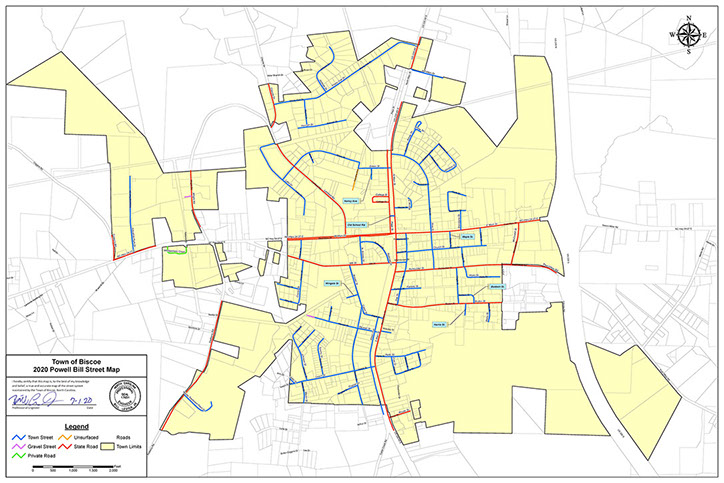Powell Bill
The Powell Bill is codified in N.C.G.S.
136-41.1 through N.C.G.S. 136-41.4
N.C.G.S. 136-41.3 provides, in part: “the
funds allocated to cities and towns under
the provisions of G.S. 136-41.2 shall
be expended by said cities and towns
primarily for resurfacing of streets within
the corporate limits of the municipality
but may be used for the purposes of
maintaining, repairing, constructing,
reconstructing or widening of anystreet or public thoroughfare including bridges,
drainage, curb and gutter, and other necessary appurtenances within the corporate limits of the municipality or for meeting
the municipality’s proportionate share of assessments levied for such purposes, or for the
planning, construction and maintenance of bikeways, greenways or sidewalks.”
To learn more about the Powell BIll, click here
WHOSE RESPONSIBILITY IT IS TO MAINTAIN YOUR STREET?
POWELL BILL OVERVIEW
The Powell Bill funds are used primarily to resurface municipal streets but can also be used to maintain, repair, construct or widen streets, bridges, and drainage areas. Municipalities can also use Powell Bill funds to plan, construct and maintain bike paths, greenways, or sidewalks. The fund is named for Junius K. Powell, a former state senator and mayor of Whiteville. Powell was the primary sponsor of the 1951 bill that helped the state’s cities with urban road problems. The first allocation of Powell Bill funds was for $4.5 million and was distributed to 386 cities and towns. The NCDOT has begun distributing more than $147.7 million in State Street aid, also known as the Powell Bill fund, to 507 municipalities across North Carolina.
ELIGIBLE ACTIVITIES:
INELIGIBLE ACTIVITIES:
Curb, gutter, and storm drainage
Construction, maintenance, or repair on private streets
Patching
Construction or maintenance of off-streetparking areas or facilities
Resurfacing
Street name signs
Widening
Street repairs necessitated by utility installation or repairs
Snow removal
Indirect costs such as budget administration, data processing, office equipment, supplies, etc.
Sand and debris removal from natural causes
Leaf vacuums
Street sweeping
Salaries or other expenses for traffic policeman
Purchase or rental of equipment
Police Cars and motorcycles
Purchase and maintenance
Construction of equipment shed for housing street
STATE MAINTAINED ROAD SECONDARY ROAD SYSTEM OVERVIEW
State maintained roads are additionally ineligible for the Powell bill Program because
they fall underneath a system called ‘the secondary road system’. The purpose of this
Sub-chapter consists of those roads maintained by the Department of Transportation
that do not carry “NC” or “US” numbers and are outside the boundaryof any
incorporated municipality. In the development of secondary road plans, these roads fall
into several categories which are defined as follows:
PRINCIPAL COUNTY ROUTES
These routes serve as the backbone of the rural transportation network within a county.
Their major purpose is to move local traffic to community and recreational centers,
shopping, and industrial areas, to urban areas within the county and to connect
together the other secondary roads with the primary highway system. In addition, they
serve abutting residential, farming, business, and industrial property.
COUNTY ROADS
These roads have as their primary purpose serving abutting residential, farming,
business, and industrial use. They also carry small to moderate volumes of traffic
moving to the principal county routes and the primary highway system. Their dual
function of serving traffic and abutting property is variable depending upon their
importance as a through route or connecting link.
SUBDIVISION STREETS
A subdivision street is considered to be a street or road which has been dedicated to the public to provide ingress and egress to lots or parcels which have been laid out for the purpose of providing home sites by a person or firm hoping to profit by the sale of such parcels. These lots or parcels are of insufficient size to be used primarily for farming purposes. A subdivision street is primarily for the use and convenience of the abutting property owners and not the general traveling public.
COLLECTOR ROADS
Collector roads channel traffic in subdivisions from side roads. They also provide access
from other state-maintained roads.
BISCOE POWELL BILL STREET LISTING
- Aileen Ave
- Arrow Tr
- Baldwin St
- Blake St
- Brendana Dr
- Brian St
- Brooks St
- Butler St
- Cagle St
- Capel St
- Carolina Ave
- Cedar St
- Church St Clegg St
- Clyde St
- Craven St
- Davis St
- Emerywood Dr
- English Dr
- Factory St
- First St
- Gary St
- Green St
- Gregg St
- Hampshire St
- Hannah Dr
- Harris St
- Hicks St
- Hurley St
- Hyde St
- Industrial Park Dr
- Jackson Dr
- Jeff Allen Drive
- John St
- Johnson St
- Kanoy St
- Lake Dr
- Leach St
- Manse St
- Maple St
- Martin St
- McAuley St
- Myrick Dr
- N. Brooks
- Nancy Ave
- Oak St
- Old School Rd
- Pine St
- Pineland Ct
- Professional Dr
- Railroad St
- Second St
- Shady Oak/DOT Road
- (300 ft on both
- ends - Town in the
- Middle.)
- Shamburger St
- Stewart St
- Third St
- Tommy St
- Unnamed St
- Waste Treatment
- Plant Dr
- Windsor Dr
- Wingate St
NC DEPARTMENT OF TRANSPORTATION BISCOE STREET LISTING
- North Main St/220 N
- S Main St/220 S
- East Main St/24-27 East
- West Main St/24-27 West
- Page Street
- Lambert Road
- Shady Oak/DOT Road
- (300 ft on both ends -
- Town in the Middle)
- Airport Road
- Wright Road
- Sedberry Road
- Rouse St
- Martin St. Ext.
- Hunsucker St.
- Bruton St.
- Mill St.
- RL Kellam St.
- John St (1/2 Town ½ DOT)
- Road behind Old School off of Lambert

